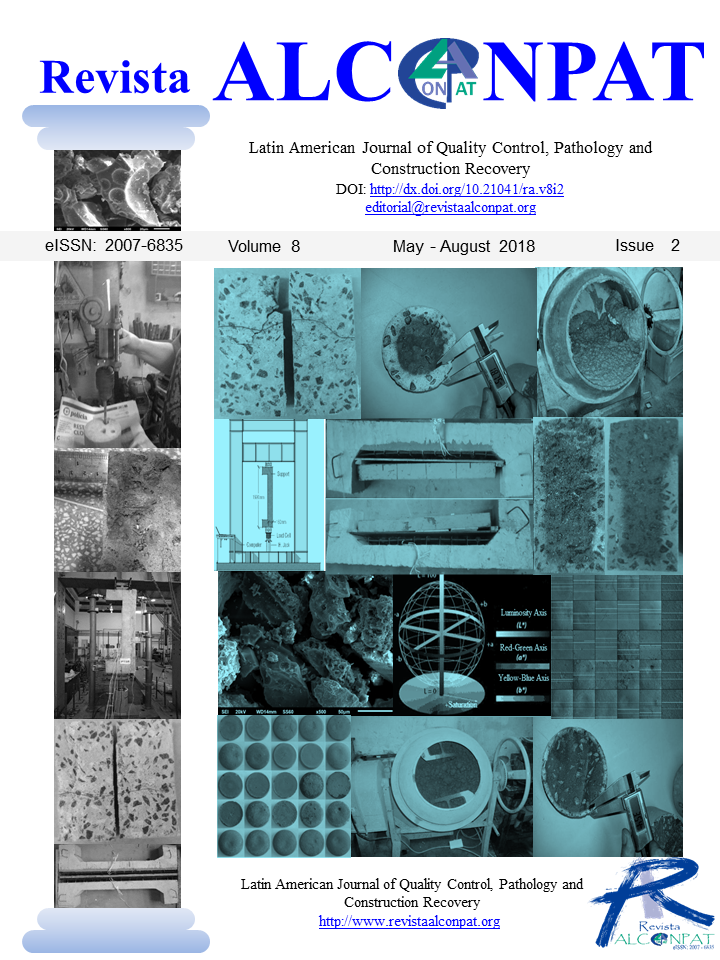Comparative assessment of the mechanical behaviour of aerated lightweight concrete
Abstract
The present study aims to discuss the effect of air entrainment on the mechanical behavior and durability of molded concrete elements. The experiment was carried out using samples with 4 different masses (1500 kg/m3, 1700 kg/m3, 2000 kg/m3, and 2300 kg/m3) and 3 water/cement ratios (0.63-1:5, 0.50-1:4, 0.43-1:3) that were tested to determine compressive strength, water absorption, void index, and carbonation depth. The results showed significant decreases in performance and in the protection indicators of the armature (water absorption and carbonatation), confirming the need for additional mitigation for the structure (protective paints, stainless steel bars), under penalty of premature loss of durability over its lifetime.
Downloads
References
ABNT - Associação Brasileira de Normas Técnicas (1992), NBR 12645: Execução de paredes de concreto celular espumoso moldadas no local - Procedimento. Rio de Janeiro.
ABNT - Associação Brasileira de Normas Técnicas (2012), NBR 16055: Parede de concreto moldada no local para a construção de edificações – Requisitos e procedimentos. Rio de Janeiro, Brasil.
ABNT - Associação Brasileira de Normas Técnicas (2015), NBR 8953: Concreto para fins estruturais – Classificação pela massa específica, por grupos de resistência e consistência. Rio de Janeiro, Brasil.
ABNT - Associação Brasileira de Normas Técnicas (2007), NBR 5739: Concreto - Ensaios de compressão de corpos-de-prova cilíndricos. Rio de Janeiro, Brasil.
ABNT - Associação Brasileira de Normas Técnicas (2015), NBR 12655: Concreto de cimento Portland - Preparo, controle, recebimento e aceitação – Procedimento. Rio de Janeiro, Brasil.
ABNT - Associação Brasileira de Normas Técnicas (2009), NBR 9778: Argamassa e concreto endurecidos - Determinação da absorção de água, índice de vazios e massa específica. Rio de Janeiro, Brasil.
ABNT - Associação Brasileira de Normas Técnicas (2012), NBR 9779: Argamassa e concreto endurecidos — Determinação da absorção de água por capilaridade. Rio de Janeiro, Brasil.
ABNT - Associação Brasileira de Normas Técnicas (1992), NBR 12646 - Paredes de concreto celular espumoso moldadas no local - Especificação. Rio de Janeiro, Brasil.
ASTM International. (2017). ASTM C150/C150M-17 Standard Specification for Portland Cement. Retrieved from https://doi.org/10.1520/C0150_C0150M-17
ASTM International. (2013). ASTM C1585-13 Standard Test Method for Measurement of Rate of Absorption of Water by Hydraulic-Cement Concretes. Retrieved from https://doi.org/10.1520/C1585-13
ASTM International. (2010). ASTM C1084-10 Standard Test Method for Portland-Cement Content of Hardened Hydraulic-Cement Concrete. Retrieved from https://doi.org/10.1520/C1084-10
ASTM International. (2017). ASTM C231/C231M-17a Standard Test Method for Air Content of Freshly Mixed Concrete by the Pressure Method. Retrieved from https://doi.org/10.1520/C0231_C0231M-17A
ASTM International. (2018). ASTM C39/C39M-18 Standard Test Method for Compressive Strength of Cylindrical Concrete Specimens. Retrieved from https://doi.org/10.1520/C0039_C0039M-18
ASTM International. (2017). ASTM C29/C29M-17a Standard Test Method for Bulk Density (“Unit Weight”) and Voids in Aggregate. Retrieved from https://doi.org/10.1520/C0029_C0029M-17A
Bauer, L. A. F. (1994), Materiais de Construção: 5.ed. Rio de Janeiro: ABDR Afiliada, v.1.f
Corsini, R. (2011) Paredes normatizadas. Norma inédita para paredes de concreto moldadas in loco entra em vigor e promete impulsionar uso da tecnologia em edificações. In: Revista Téchne, No. 183. Dezembro de 2011. Disponível em: <http://techne.pini.com.br/engenharia-civil/183/paredes-normatizadas-norma-inedita-para-paredes-de-concreto-moldadas-287955-1.aspx>
Du, L., Folliard, J. K. (2005), Mechanisms of air entrainment in concrete. Cement and Concrete Research, v. 35, n. 8, p. 1463-1471. https://doi.org/10.1016/j.cemconres.2004.07.026
Fujii, A. L., Torres, D. R., Romano, R. C. O., Cincotto, M. A., Pileggi, R. G. (2015), Impact of superplasticizer on the hardening of slag Portland cement blended with red mud. Construction & Building Materials, v. 101, p. 432-439. https://doi.org/10.1016/j.conbuildmat.2015.10.057
Helene, P., Andrade, T. (2007), Concreto de cimento Portland. In: Isaia, Geraldo Cechella. Materiais de Construção Civil e Princípios de Ciência e Engenharia de Materiais. São Paulo: IBRACON. V2, Cap. 27, p. 905 -944.
Kumaran, K., Lackey, J., Normandin, N., Van Reenen, D., Tariku, F. (2004), "Heat, Air and Moisture Transport Properties of Several North American Bricks and Mortar Mixes", Journal of Testing and Evaluation, v. 32, n. 5, pp. 383-389. https://doi.org/10.1520/JTE12079
Mehta, P. K., Monteiro, P. J. (2014), Concreto: microestrutura, propriedades e materiais. 2ª ed. IBRACON. p. 313.
Helene, P., Terzian P. (1992), Manual de Dosagem e Controle do Concreto, São Paulo, SP, Ed. Pini.
RILEM TC (1994). CPC 18 Measurement of hardened concrete carbonation depth, 1988. RILEM Recommendations for the Testing and Use of Constructions Materials. e-ISBN: 2351580117, Publisher: E & FN SPON, Pages: 56 – 58, RILEM.
Rossignolo, J. A. (2009), Concreto Leve Estrutural. Produção, Propriedades Microestrutura e Aplicações. São Paulo: Editora Pini.
Romano, R. C. O., Torres, D. R., Pileggi, R. G. (2015), Impact of aggregate grading and air-entrainment on the properties of fresh and hardened mortars. Construction & Building Materials, v. 82, p. 219-226. https://doi.org/10.1016/j.conbuildmat.2015.02.067
Romano, R. C. O., Maciel, M. H., Cincotto, M. A., Pileggi, R. G. (2017), Monitoring of hardening of Portland cement suspension by Vicat test, oscillatory rheometry, and isothermal calorimetry. APPLIED RHEOLOGY, v. 27, p. 36006. http://doi.org/10.3933/ApplRheol-27-36006
Teixeira Filho, F. J., Tezuka, Y. (1992), Considerações Sobre Algumas propriedades dos Concretos Celulares Espumosos. Boletim Técnico da Escola Politécnica da USP. Departamento de Engenharia da Construção Civil. São Paulo. EPUSP.
Torres, D. R., Fujii, A. L., Romano, R. C. O., Pileggi, R. G. (2014), Impacto da rota de incorporação de ar nas propriedades de materiais cimentícios. Ambiente Construído (Online), v. 14, p. 141-152. http://dx.doi.org/10.1590/S1678-86212014000200010
Whiting, D. A., Saak, A. W., Jennings, H. M. (1999), The influence of mixing on the rheology of fresh cement paste. Cement and Concrete Research, Volume 29, Issue 9, September 1999, Pages 1491-1496. https://doi.org/10.1016/S0008-8846(99)00124-6
_______________________________
License in effect from September 2020
You are free to:
- Share — copy and redistribute the material in any medium or format for any purpose, even commercially.
- Adapt — remix, transform, and build upon the material for any purpose, even commercially.
- The licensor cannot revoke these freedoms as long as you follow the license terms.
Under the following terms:
- Attribution — You must give appropriate credit , provide a link to the license, and indicate if changes were made . You may do so in any reasonable manner, but not in any way that suggests the licensor endorses you or your use.
- No additional restrictions — You may not apply legal terms or technological measures that legally restrict others from doing anything the license permits.
Notices:
You do not have to comply with the license for elements of the material in the public domain or where your use is permitted by an applicable exception or limitation .
No warranties are given. The license may not give you all of the permissions necessary for your intended use. For example, other rights such as publicity, privacy, or moral rights may limit how you use the material.





















.png)














